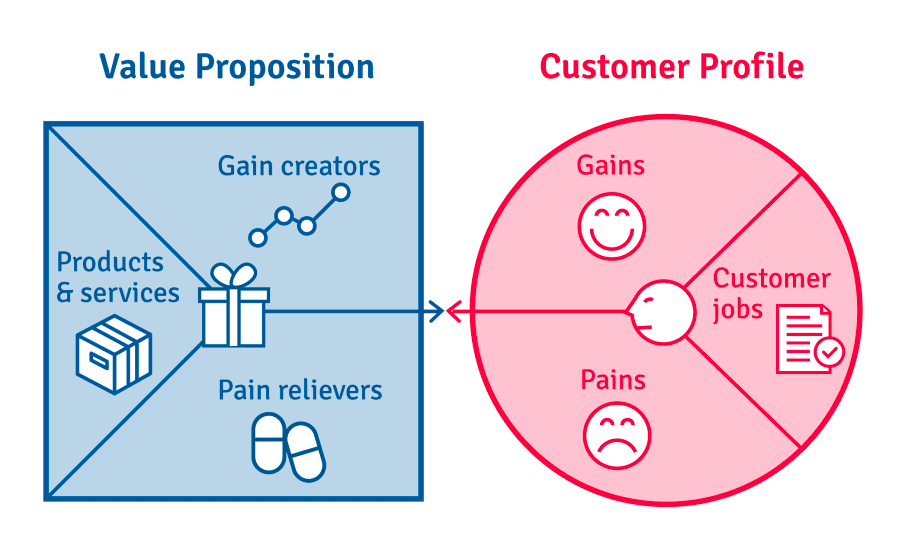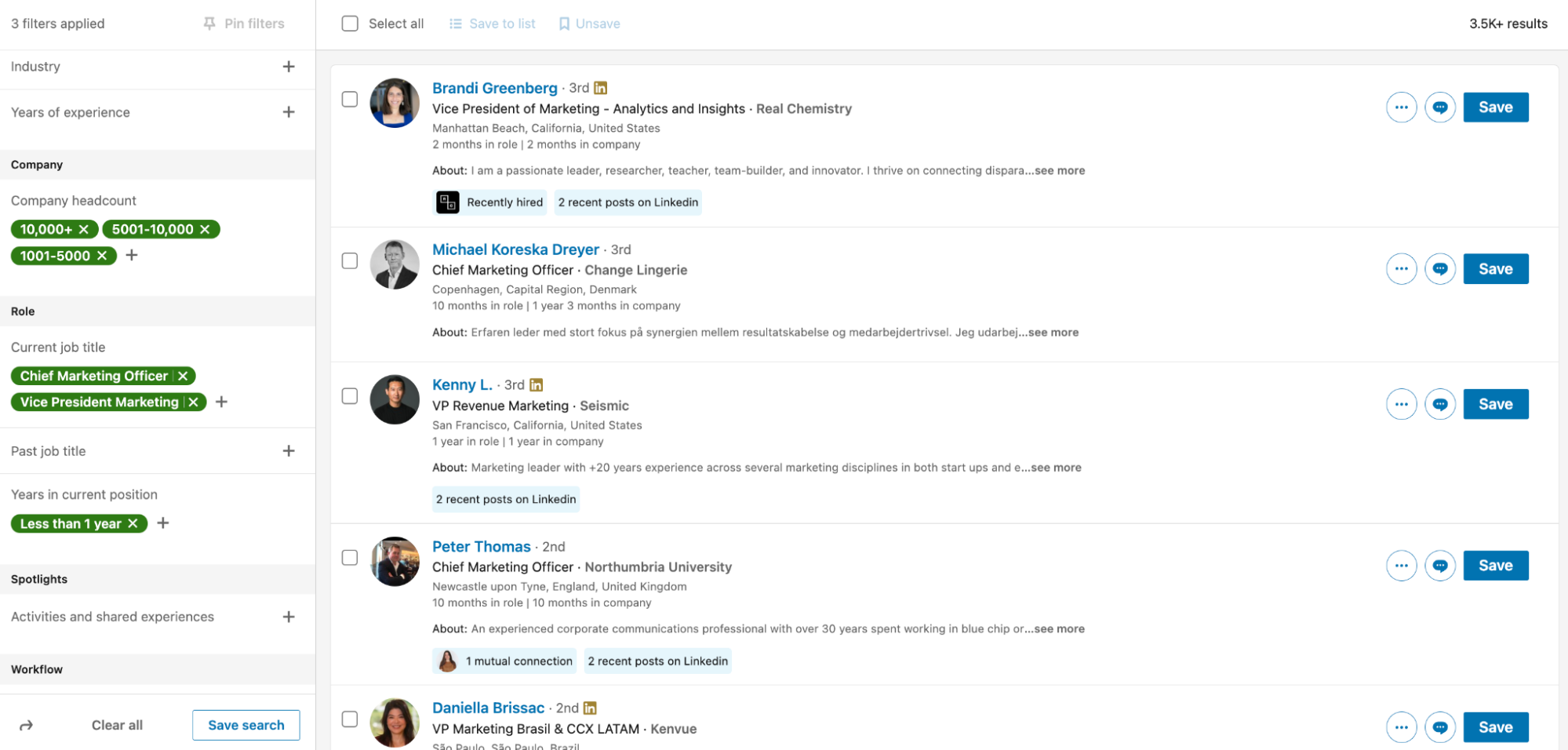To send great email outreach, you need a clear understanding of:
- Who your prospects are,
- What pains they experience or what gains they desire, and
- How you can provide gains and alleviate their pains.
If you can align these elements, sending cold emails will be easier. That's where the Value Proposition Canvas comes in.
What is the Value Proposition Canvas
The Value Proposition Canvas is a tool to find and align your value proposition and your ideal customer profile.
Alexander Osterwalder created it to supplement his Business Model Canvas, a template for developing business models. You can use the Value Proposition Canvas independently, though.
The Value Proposition Canvas connects your product or service directly with the jobs-to-be-done (JTBD) of your prospects. Instead of using the dated persona-based approach, the Value Proposition Canvas leverages a more modern way of thinking about your prospects as people with specific tasks to accomplish.

The right side, which is the Customer Profile, lists the customer jobs. These are tasks that your customers face or want to complete. After listing the key jobs to be done, you also outline:
- Pains or obstacles your prospect faces when trying to get their jobs done,
- Gains (results, benefits) they want to achieve.
The left side, the Value Map, describes your product or service (or a specific feature if you want to get granular). It also specifies:
- Pain relievers – ways in which your product alleviates the pains and obstacles for your customers,
- Gain creators – how your product provides or increases the benefits your customers are looking for.
When working with the Value Proposition Canvas, I aim to achieve a fit: an alignment between what I'm offering and what my ideal customers need.
How Value Proposition Canvas helps send better cold emails
The Value Proposition Canvas helps you define which features of your product or service satisfy the specific needs of your customers.
Highlighting this alignment works wonders for sending cold emails that drive results.
There’s a variety of specific ways in which the Value Proposition Canvas makes email outreach easier:
Targeting
The more precise your customer profile, the easier to find qualified prospects. The specific jobs-to-be-done, pains, and gains are shared ICP attributes you’ll later use to find prospects at scale.
Personalization
If you find prospects based on their pains and gains, you can use powerful personalization and make your email truly relevant.
Reciprocity
By understanding how you alleviate pains and provide gains, you’ll know how to balance what you're asking for with what you can offer in your email.
Copywriting
Aligned pairs of pains and pain relievers, as well as gains and gain creators, are content you can copy and paste into your emails with little editing.
How to use the Value Proposition Canvas
You can find a free, editable version of the Value Proposition Canvas on Figma.
You can start anywhere on the canvas, which may feel intimidating.
Here’s my recommendation:
If you have existing customers you’re satisfied with, leverage them and start with the Customer Profile. You can conduct customer interviews to get a better understanding of their jobs to be done, pains, and gains.
Once we have enough data points (~100 customers or so), I go back to the data and look at what sets our best (longest staying, highest paying, best to work with) customers from those who churn or are unhappy. Then we adjust our messaging, service. and marketing around that ideal customer.
If you have an existing product or service, but you’re still looking for ideal customers, use your pain relievers and gain creators to reverse-engineer your Customer Profile.
If you’re creating a new product from scratch, try simultaneous development. Create a preliminary Value Map based on your vision and then draft a Customer Profile. Refine both in tandem.
Value Proposition Canvas – Before and after
Let’s analyze and improve an unsuccessful cold email by leveraging the Value Proposition Canvas.

Here’s what I think could be improved:
- Targeting: The sender provides outdoor advertising. I’ll be honest – I don’t know much about this market, but in my experience, outdoor advertising is generally used in brand marketing, and it is typically leveraged by enterprise organizations with enormous budgets. Hunter is not the best fit.
- Benefits: I have no idea why “patented scientific targeting” or “AI-powered recommendation engine” would be needed in out-of-home advertising. To me, these aren’t benefits but examples of confusing insider lingo.
- Clarity: “Drive fresh growth for Hunter” is not specific. It’s no wonder – if you’re unsure what problems you’re solving and for whom, how can you clearly communicate it?
I'll now create a Value Proposition Canvas to simulate and polish this campaign.

I made some assumptions here that might be debatable, but that’s not the point.
Here's what I can do next:
- I would narrow my customer profile down to a VP of Marketing at an enterprise company who is new to the role. This ICP is best positioned to be interested in my solution.
- Since my ICP is constructed using professional demographics data, I can use a professional demographics data provider like LinkedIn Sales Navigator to find prospects, and then I'd save them to a new prospect list.

- Using PhantomBuster or Vayne.io, I can scrape my list of prospects, including their location.
- Using their location and ChatGPT, I can find attractive ad spots in each location – I'll use this to personalize my cold emails,

- Finally, I can use Hunter to find the verified emails of my prospects.
Now, let’s get to rewriting the email!
<<first name>>,
I'm hearing from many marketing leaders that attribution is the #1 obstacle preventing them from running more outdoor ads.
Wouldn't it be awesome to run brand ads at <<location 2>> or <<location 3>> and get accurate numbers for how many website visitors they're driving?
Our new AI product does exactly that, and with our experience buying outdoor ad space, we can drive local traffic with a much higher ROI than online advertising.
If you'd like to hear more, I can send specific estimates for the costs & ROI of outdoor ads in your location.
Best,
Ziemek
Why my version of the email is better
- Thanks to narrowing down the professional demographics of my ideal customer, I can use effortless personalization that helps the recipient visualize the value,
- Having diagnosed pains and gains, I can tap into them and leverage my pain relievers and gain creators.
Next steps
After you work on your Value Proposition Canvas, you’ll be eager to start looking for prospects.
But not so fast! You also need a clear WARM goal for your cold email campaign.

